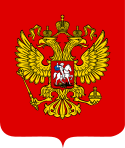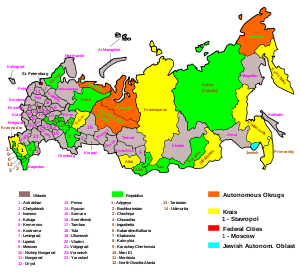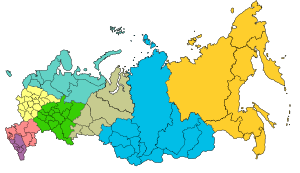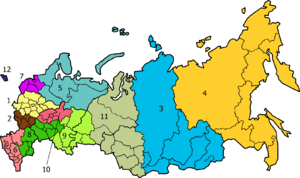- Subdivisions of Russia
-
Russia 
This article is part of the series:
Politics and government of
Russia- Russian Constitution of 1906
- Russian Constitution of 1918
- 1924 Soviet Constitution
- 1936 Soviet Constitution
- 1977 Soviet Constitution
- Russian Constitution of 1978
- Constitution of Russia 1993
Legislature- Prime Minister
- First Deputy Prime Minister
- Constitutional Court
- Supreme Court
- Supreme Court of Arbitration
- Legal system
- President
- Parliament
- Referendums
- Central Election Commission
- Political parties
Other issues
Russia is divided into several types and levels of subdivisions.
Contents
Federal subjects
Russia is a federation which since March 1, 2008 consists of 83 federal subjects (members of the Federation).[1] These federal subjects are of equal federal rights in the sense that they have equal representation—two delegates each—in the Federation Council (upper house of the Federal Assembly). They do, however, differ in the degree of autonomy they enjoy.
Six types of federal subjects are distinguished—21 republics, 9 krais, 46 oblasts, 2 federal cities, 1 autonomous oblast, and 4 autonomous okrugs.
Autonomous okrugs are the only ones that have a peculiar status of being federal subjects in their own right, yet at the same time they are considered to be administrative divisions of other federal subjects (with Chukotka Autonomous Okrug being the only exception).
Administrative divisions
Prior to the adoption of the 1993 Constitution of Russia, the administrative-territorial structure of Russia was regulated by the Decree of the Presidium of the Supreme Soviet of the RSFSR of August 17, 1982 "On the Procedures of Dealing with the Matters of the Administrative-Territorial Structure of the RSFSR".[2] The 1993 Constitution, however, did not identify the matters of the administrative-territorial divisions as the responsibility of the federal government or as the joint responsibility of the federal government and the federal subjects.[2] This was interpreted by the governments of the federal subjects as a sign that the matters of the administrative-territorial divisions became solely the responsibility of the federal subjects.[2] As a result, the modern administrative-territorial structures of the federal subjects vary significantly from one federal subject to another. While the implementation details may be considerably different, in general, however, the following types of high-level administrative divisions are recognized:
- raions (administrative districts);
- cities/towns and urban-type settlements of federal subject significance;
- closed administrative-territorial formations.
Autonomous okrugs and okrugs are intermediary units of administrative divisions, which comprise some of the federal subject's raions and cities/towns/urban-type settlements of the federal subject significance.
- Autonomous okrugs, while being under the jurisdiction of another federal subject, are still constitutionally recognized as federal subjects on their own right. Chukotka Autonomous Okrug is an exception to this description in that it is not administratively subordinated to any other federal subject of Russia.
- Okrugs are usually former autonomous okrugs which lost their federal subject status due to mergers with other federal subjects.
Typical lower-level administrative divisions include:
- selsoviets (rural councils);
- towns and urban-type settlements of the administrative district significance;
- city districts.
 Administrative divisions of the federal subjects of Russia
Administrative divisions of the federal subjects of RussiaRepublics Adygea · Altai · Bashkortostan · Buryatia · Chechnya · Chuvashia · Dagestan · Ingushetia · Kabardino-Balkaria · Kalmykia · Karachay-Cherkessia · Karelia · Khakassia · Komi · Mari El · Mordovia · North Ossetia–Alania · Sakha · Tatarstan · Tuva · Udmurtia
Krais Altai · Kamchatka · Khabarovsk · Krasnodar · Krasnoyarsk · Perm · Primorsky · Stavropol · Zabaykalsky
Oblasts Amur · Arkhangelsk · Astrakhan · Belgorod · Bryansk · Chelyabinsk · Irkutsk · Ivanovo · Kaliningrad · Kaluga · Kemerovo · Kirov · Kostroma · Kurgan · Kursk · Leningrad · Lipetsk · Magadan · Moscow · Murmansk · Nizhny Novgorod · Novgorod · Novosibirsk · Omsk · Orenburg · Oryol · Penza · Pskov · Rostov · Ryazan · Sakhalin · Samara · Saratov · Smolensk · Sverdlovsk · Tambov · Tomsk · Tula · Tver · Tyumen · Ulyanovsk · Vladimir · Volgograd · Vologda · Voronezh · Yaroslavl
Federal cities Autonomous oblast Autonomous okrugs Municipal divisions
In the course of the Russian municipal reform of 2004–2005, all federal subjects of Russia were to streamline the structures of the local self-government, which is guaranteed by the Constitution of Russia. The reform prescribed that each federal subject have a unified structure of the municipal government bodies by January 1, 2005, and a law enforcing the reform provisions went in effect on January 1, 2006. According to the law, the units of the municipal division (called "municipal formations") are as follows:[3]
- Municipal district, a group of urban and rural settlements, often along with the inter-settlement territories. In practice, municipal districts are usually formed within the boundaries of existing administrative districts (raions).
- Urban settlement, a city/town or an urban-type settlement, possibly together with adjacent rural and/or urban localities
- Rural settlement, one or several rural localities
- Urban okrug, an urban settlement not incorporated into a municipal district. In practice, urban okrugs are usually formed within the boundaries of existing cities of federal subject significance.
- Intra-city territory of a federal city, a part of a federal city's territory. In Moscow, these are called municipal formations (which correspond to districts); in St. Petersburg—municipal okrugs, towns, and settlements.
Territories not included as a part of municipal formations are known as inter-settlement territories.
Other types of subdivisions
Federal districts
All of the federal subjects are grouped into eight federal districts,[4] each administered by an envoy appointed by the President of Russia. Federal districts' envoys serve as liaisons between the federal subjects and the federal government and are primarily responsible for overseeing the compliance of the federal subjects with the federal laws.
Economic regions
For economic and statistical purposes the federal subjects are grouped into twelve economic regions.[5] Economic regions and their parts sharing common economic trends are in turn grouped into economic zones and macrozones.
See also
- History of the administrative division of Russia
- List of federal subjects of Russia by area
- List of federal subjects of Russia by population
- Types of inhabited localities in Russia
References
- ^ Constitution, Article 65
- ^ a b c "Энциклопедический словарь конституционного права". Статья "Административно-территориальное устройство". Сост. А. А. Избранов. — Мн.: Изд. В.М. Суров, 2001.
- ^ Государственная Дума Российской Федерации. Федеральный Закон №131-ФЗ от 6 октября 2003 г. «Об общих принципах организации местного самоуправления в Российской Федерации», в ред. Федерального Закона №243-ФЗ от 28 сентября 2010 г. (State Duma of the Russian Federation. Federal Law #131-FZ of October 6, 2003 On General Principles of the Organization of Local Self-Government in the Russian Federation, as amended by the Federal Law #243-FZ of September 28, 2010. ).
- ^ Президент Российской Федерации. Указ №849 от 13 мая 2000 г. «О полномочном представителе Президента Российской Федерации в федеральном округе». Вступил в силу 13 мая 2000 г. Опубликован: "Собрание законодательства РФ", №20, ст. 2112, 15 мая 2000 г. (President of the Russian Federation. Decree #849 of May 13, 2000 On the Plenipotentiary Representative of the President of the Russian Federation in a Federal District. Effective as of May 13, 2000).
- ^ "Общероссийский классификатор экономических регионов" (ОК 024-95) введённый 1 января 1997 г., в ред. Изменения № 05/2001. Секция II. Экономические районы (Russian Classification of Economic Regions (OK 024-95) of January 1, 1997 as amended by the Amendments #1/1998 through #5/2001. Section II. Economic Regions)
Sources
- 12 декабря 1993 г. «Конституция Российской Федерации», в ред. Федерального конституционного закона №7-ФКЗ от 30 декабря 2008 г. Вступил в силу со дня официального опубликования. Опубликован: "Российская газета", №237, 25 декабря 1993 г. (December 12, 1993 Constitution of the Russian Federation, as amended by the Federal Constitutional Law #7-FKZ of December 30, 2008. Effective as of the official publication date).
External links
Subdivisions of Asia Sovereign
states- Afghanistan
- Armenia
- Azerbaijan
- Bahrain
- Bangladesh
- Bhutan
- Brunei
- Burma (Myanmar)
- Cambodia
- People's Republic of China
- Cyprus
- East Timor (Timor-Leste)
- Egypt
- Georgia
- India
- Indonesia
- Iran
- Iraq
- Israel
- Japan
- Jordan
- Kazakhstan
- North Korea
- South Korea
- Kuwait
- Kyrgyzstan
- Laos
- Lebanon
- Malaysia
- Maldives
- Mongolia
- Nepal
- Oman
- Pakistan
- Philippines
- Qatar
- Russia
- Saudi Arabia
- Singapore
- Sri Lanka
- Syria
- Tajikistan
- Thailand
- Turkey
- Turkmenistan
- United Arab Emirates
- Uzbekistan
- Vietnam
- Yemen
States with limited
recognition- Abkhazia
- Nagorno-Karabakh
- Northern Cyprus
- Palestine
- Republic of China (Taiwan)
- South Ossetia
Dependencies and
other territories- Christmas Island
- Cocos (Keeling) Islands
- Hong Kong
- Macau
Categories:- Subdivisions of Russia
- Subdivisions by country
- Country subdivisions of Europe
- History of Russia (1992–present)
- Russia-related lists
Wikimedia Foundation. 2010.




